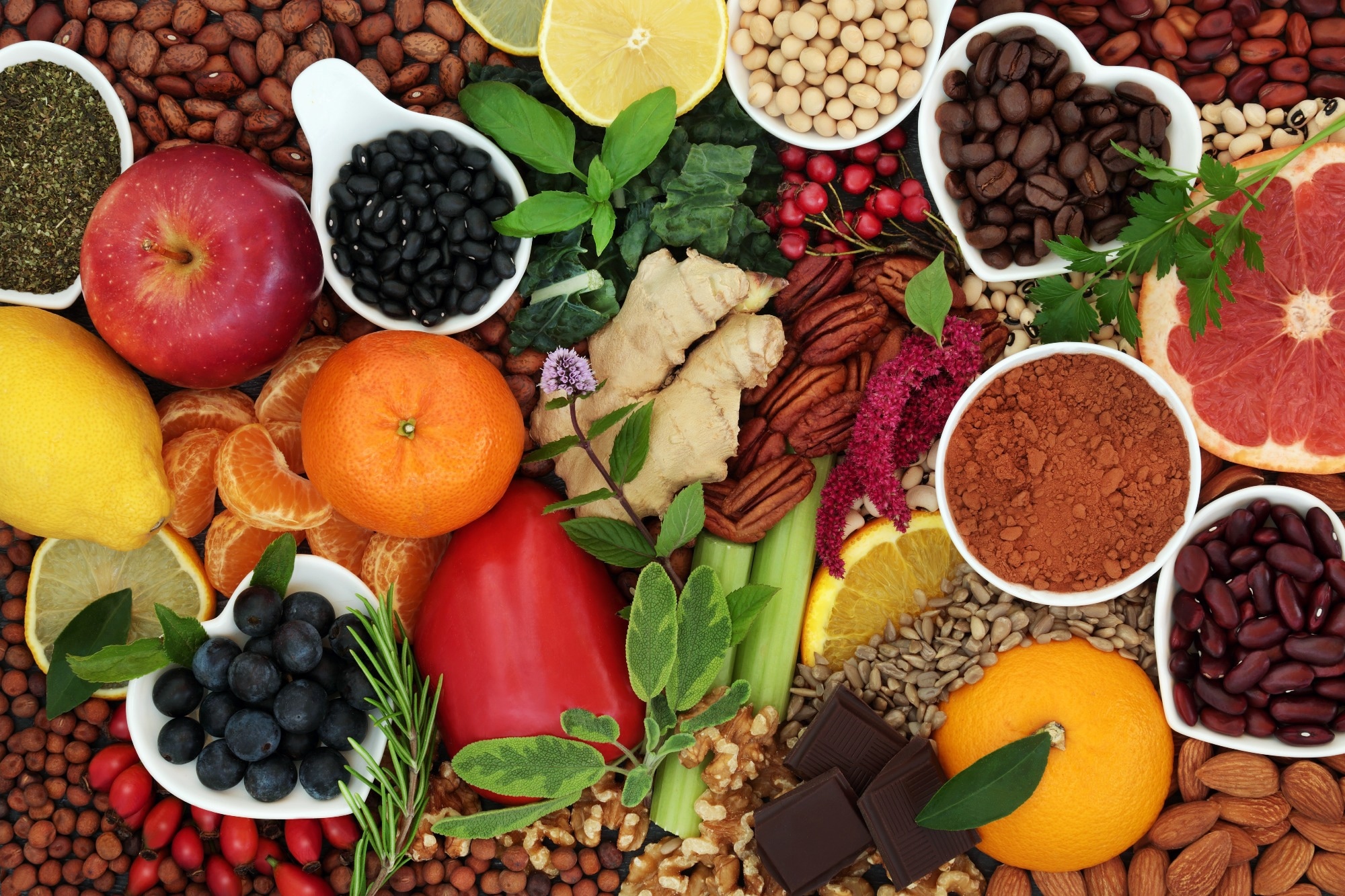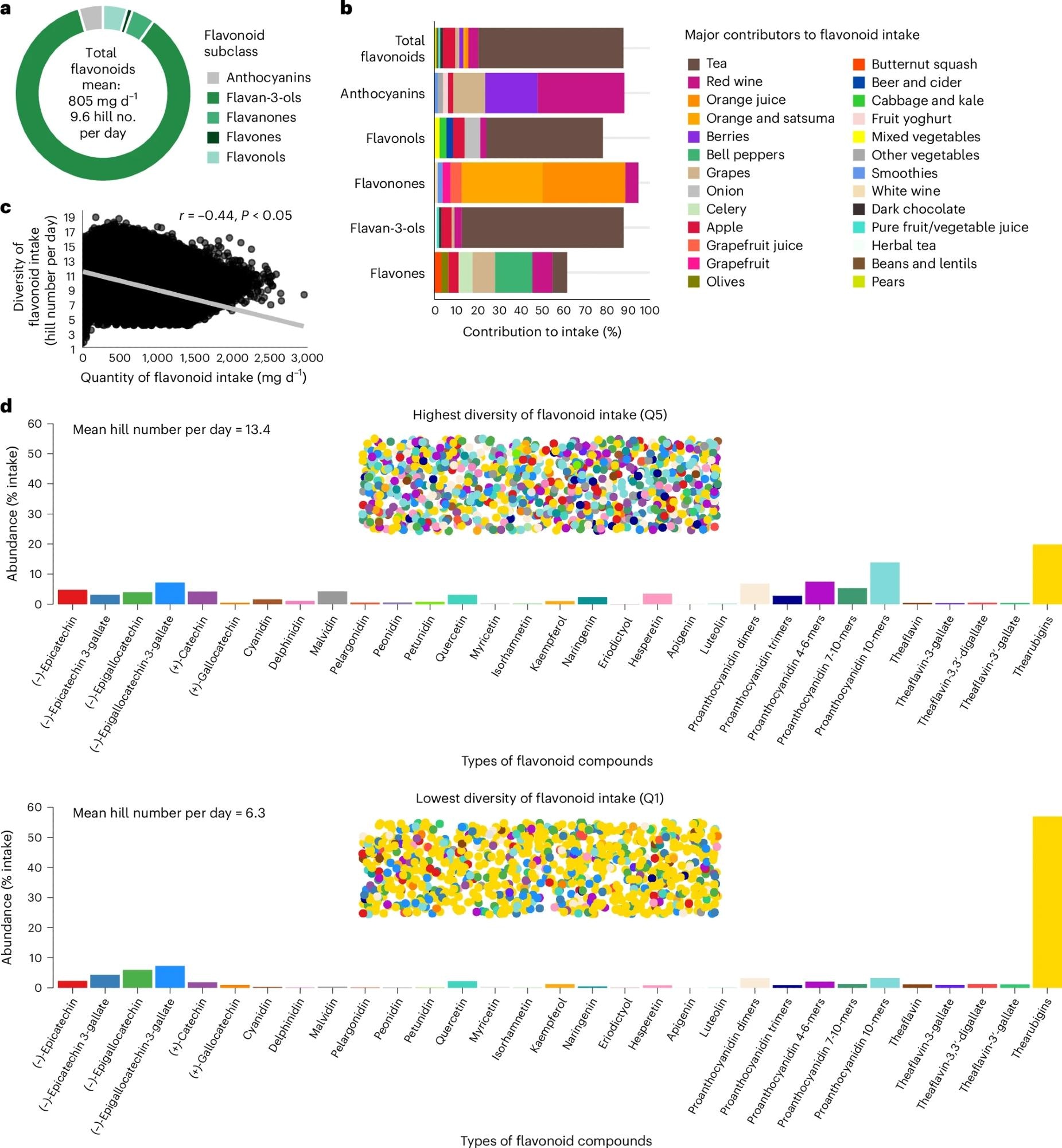What is the simple secret to living longer and reducing your risks for heart disease, diabetes, and cancer? Mixing up your daily fruits, veggies, and teas suggests an extensive study.
 Study: High diversity of dietary flavonoid intake is associated with a lower risk of all-cause mortality and major chronic diseases. Image credit: marilyn barbone/Shutterstock.com
Study: High diversity of dietary flavonoid intake is associated with a lower risk of all-cause mortality and major chronic diseases. Image credit: marilyn barbone/Shutterstock.com
A recent study published in the journal Nature Food highlights the importance of consuming a variety of dietary flavonoids in reducing the risks of chronic diseases and all-cause mortality.
Background
Flavonoids are polyphenolic compounds present in the human diet. These compounds are found in various foods and beverages, including vegetables, fruits, nuts, legumes, wines, and tea.
Several subclasses of flavonoids are present in different foods and beverages, including flavonols, anthocyanins, flavan-3-ols, flavanones, and flavones. Due to variations in their chemical structure, bioavailability, and metabolism, these subclasses have a range of biological effects.
The most prominent and well-documented properties of different flavonoids include antioxidant, anti-inflammatory, anticancer, and cardio-protective properties, crucial for reducing the risk of chronic diseases and related mortality.
Some flavonoids have more specific functions, such as promoting endothelial function, delaying age-related tissue deterioration, and exerting antiproliferation effects related to cancer prevention.
Given that different flavonoids exert varying biological effects, the current study was designed to evaluate the impact of consuming a diverse range of dietary flavonoids on the risk of major chronic diseases and all-cause mortality.
The study population comprised 124,805 participants from the UK Biobank, an extensive population-based cohort study involving over 500,000 participants.
Participants were adults aged 40 or older, with a median age of about 60. Over a follow-up period of 8.7-10.6 years, researchers recorded incidences of mortality and chronic diseases, including cardiovascular disease (CVD), type 2 diabetes, cancer, respiratory diseases, and neurodegenerative diseases.
Impact of total flavonoids on chronic diseases and all-cause mortality
After adjusting for sociodemographic, lifestyle, dietary, and medical risk factors, the study found that both the quantity and variety of flavonoids in a person’s diet are independently associated with a lower risk of several chronic diseases and reduced overall mortality.
Specifically, participants with the highest diversity of flavonoid intake exhibited a 14% lower risk of all-cause mortality, a 10% lower risk of cardiovascular disease, a 20% lower risk of type 2 diabetes, an 8% lower risk of cancer, and an 8% lower risk of respiratory disease.
No association was observed between flavonoid diversity and risk of neurodegenerative diseases except at the highest overall levels of flavonoid intake, where a 20% lower risk was observed.
Considering the diversity constant, the study found that participants who consumed approximately 500 mg of flavonoids per day had a lower risk of all-cause mortality, cardiovascular disease, diabetes, and respiratory disease than those who consumed approximately 230 mg of flavonoids per day. The lowest risk of diabetes, cancer, and neurodegenerative diseases was observed among participants who consumed the highest quantity of flavonoids (approximately 1400 mg per day).
Interestingly, the study found that a higher total quantity of flavonoid intake was associated with lower diversity, often reflecting a diet dominated by a single source. Such instances of single-source intake were dominated by tea. Those with high diversity included a wider range of foods, such as berries, apples, grapes, red wine, and oranges.
 a, Composition of flavonoid intake. b, Major dietary contributors to flavonoid intake, showing the topmost contributors to intake only; blank spaces up to 100% represent other smaller contributors that are not shown. c, Two-sided Pearson correlation between quantity and diversity of flavonoid intake. d, Diversity of flavonoid consumption among participants with the most (Q5) and least (Q1) diverse intakes. In d, the bar charts are matched for quantity of flavonoid intake (1,000 mg d−1) and show the average abundance (% intake) of each flavonoid per day. The dotted areas represent each diet, where each circle is an individual flavonoid and each colour is a different flavonoid (corresponding to the colours and distribution on the bar charts). Data from participants with ≥2 Oxford WebQ dietary questionnaires (n = 124,805).
a, Composition of flavonoid intake. b, Major dietary contributors to flavonoid intake, showing the topmost contributors to intake only; blank spaces up to 100% represent other smaller contributors that are not shown. c, Two-sided Pearson correlation between quantity and diversity of flavonoid intake. d, Diversity of flavonoid consumption among participants with the most (Q5) and least (Q1) diverse intakes. In d, the bar charts are matched for quantity of flavonoid intake (1,000 mg d−1) and show the average abundance (% intake) of each flavonoid per day. The dotted areas represent each diet, where each circle is an individual flavonoid and each colour is a different flavonoid (corresponding to the colours and distribution on the bar charts). Data from participants with ≥2 Oxford WebQ dietary questionnaires (n = 124,805).
Impact of flavonoid subclasses on chronic diseases and all-cause mortality
A broader diversity of flavonoid intake within the flavan-3-ol and flavanone subclasses is associated with a lower risk of all-cause mortality, even after adjusting for potential confounding factors.
Participants with the broadest diversity of flavonoid intake within the flavan-3-ol subclass exhibited 13% and 8% lower risks of diabetes and cancer, respectively. Similarly, the flavanone subclass was associated with 7% and 6% lower risks of cancer and respiratory diseases, respectively. Among participants with the broadest diversity of intake within the flavone subclass, a 13% and 18% lower risk of diabetes and neurodegenerative diseases, respectively, was observed.
However, for some disease endpoints, such as neurodegenerative disease, not all flavonoid subclasses or all levels of diversity showed significant associations. This highlights that benefits may vary by both subclasses and health outcomes.
Impact of flavonoid-rich foods on chronic diseases and all-cause mortality
The study analysis, adjusting for confounding factors, revealed a progressively lower risk of all-cause mortality with a higher diversity of flavonoid-rich food intake. Participants who consumed more than four servings of flavonoid-rich foods or beverages exhibited a 16% lower risk of all-cause mortality compared to those who consumed one adequate serving.
The study found an 8% lower risk of respiratory disease among participants with the highest diversity of flavonoid-rich food intake, particularly in relation to chronic disease outcomes.
No strong associations were found between the diversity of flavonoid-rich food intake and the incidence of certain diseases, such as cancer or neurodegenerative diseases.
Notably, disregarding diversity, a higher quantity of flavonoid-rich foods beyond a certain threshold was mainly associated with a lower risk of type 2 diabetes rather than across all endpoints.
Among the key contributors to flavonoid intake, tea (black and green) was the primary source, totaling 67%. This was followed by apples, red wine, berries, dark chocolate, oranges, and orange juice, each providing distinct types of flavonoids.
Study significance
The study reveals that consuming a higher quantity and broader diversity of flavonoids, flavonoid-rich foods, or specific flavonoid subclasses is better for long-term health benefits than consuming a higher quantity or a higher diversity of flavonoids alone.
According to the study findings, the risk of all-cause mortality and the incidence of several chronic diseases can be reduced by consuming the widest diversity of flavonoids and flavonoid-rich foods and beverages, such as tea, berries, apples, oranges, and grapes.
The health benefits of flavonoids can be attributed to their multiple biological activities, including inhibition of platelet aggregation, improvement of nitric oxide bioavailability, reduction of endothelial cell oxidative stress, modulation of vascular ion channel activity, mitigation of atherosclerotic lesion formation, improvement of insulin sensitivity, reduction of inflammatory responses, inhibition of cancer cell growth, induction of cancer cell death, and prevention of angiogenesis and cancer cell invasion.
The 2022 dietary flavonoid guideline recommends consuming 400 to 600 mg of flavan-3-ols daily for potential cardiometabolic health benefits. The study findings suggest that future guidelines could be altered to consider recommending intake from various sources.
Due to the observational study design, the researchers were unable to determine the causality of the observed associations. The Oxford WebQ dietary questionnaires used in the study do not capture data on certain types of flavonoid-rich foods, which may limit the diversity assessment for specific subclasses, such as anthocyanins.
Despite the limitations, the study suggests that the simple inclusion of several different servings of flavonoid-rich foods or beverages in the daily diet may significantly impact population health.
The study’s results indicate that aiming for greater diversity and quantity of flavonoid intake, especially from various plant-based foods and beverages, may offer more health benefits than focusing on a single source or high intake alone.
Download your PDF copy now!